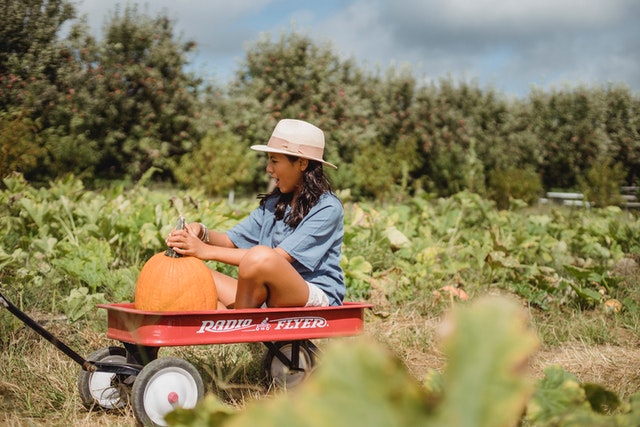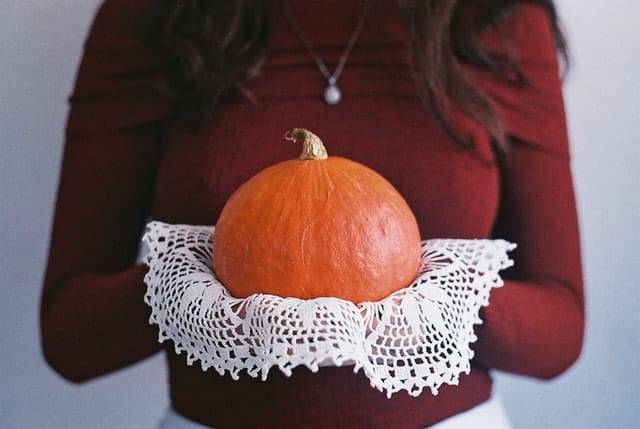Pumpkins have been growing for the past 5000 years in North America, making them native to America. They are a part of western culture, especially during the festive season. Carved pumpkins light up Halloween, and thanksgiving is incomplete without pumpkin pies. With their rich history and cultural significance, growing pumpkins in your own yard can be a rewarding experience, and careful monitoring of their growth can help ensure a healthy harvest.
Most people prefer to grow them in their yards. These easy-to-maintain plants need sizable growing space and plenty of water. If you ensure 75 to 100 frost-free days, harvesting one is a breeze. Pumpkin growers measure and weigh them from time to time to ensure their growth rate is healthy enough. If they find any discrepancies, they assess the factors responsible and fix the issue.
Knowing how much the average pumpkin weighs makes it easy to check if the growth is proper. Read on to learn more on how much does the average pumpkin weigh.
How Much Does The Average Pumpkin Weigh?

You can find a varied range of pumpkins from mini to giant size. A jack-o-lantern, the carving pumpkin is 20 to 30 lbs. A mini one weighs about ¼ lb. Usual pumpkins used for eating are medium to small-sized, weighing around 5 to 10 lbs.
The giant pumpkin weighs around 100 to 300 lbs. but can go up to 1000 lbs. In 2021, the world’s most giant pumpkin weighed 2,703 lbs. grown by Stefano Cutrupi from Italy. It was also recorded in the Guinness Book of World Records as the giant pumpkin.
All pumpkins are edible, but some are well suited for decoration, and few taste good to eat. Their weight not only depends on their variety but also on the nutrients and water they receive during the growth.
Varieties Of Pumpkins And Their Possible Weight
Pumpkins such as Jack-be-little, Baby Boo, and Apprentice weigh below 1 lb. and take around 90 days to grow till harvest. Baby Pam mini pumpkin takes about 100 days to grow and weighs about 3 to 4 lbs.
Small-sized pumpkins such as Early Abundance and Small Sugar can weigh up to 7 lbs. Cannon Ball is about 5 lbs. Pumpkins like Musquee De Provence and Casper weigh 15 lbs. The other medium-sized pumpkins that weigh around 20 lbs. are Connecticut Field and Secretariat.
Gladiator, Bunch ‘O Warts, Howden, and Early King are giant variety pumpkins weighing around 25 lbs. Coming to giant-sized pumpkins – Growers Giant is 50 – 200 lbs. Big Max weighs about 100 lbs. Prizewinner, Atlantic Giant, can range from 100 – 300 lbs. and above.
Tips For Growing Perfect Pumpkins

Though pumpkins grow well when appropriately tended, these tips help you grow perfect versions of them.
- Pumpkins require heavy feeding of nutrients through compost, manure, and fertilization.
- Early plants require nitrogen fertilizer, whereas before blooming period needs phosphorus.
- Focus the energy on fruit by trimming off the extended vines and new blooms after the fruits are formed.
- Gently turn the fruit from time to time without damaging the stem or vine for even growth on all sides.
- Put a thin board below ripening pumpkins to protect from insect damage and decay.
Factors That Determine How Large A Pumpkin Can Grow
A few essential factors that play a significant role in determining the size of a pumpkin are listed below.
- Spacing – 50 to 100 sq ft of space is required from plant to plant for the vine to grow enough to support the pumpkin.
- Pruning the Vines – secondary and tertiary vines development should not be encouraged as they not only overcrowd your garden but also take up nutrients unnecessarily. Pruning them keeps the plant area in check and helps the fruit grow optimally using available nutrients.
- Remove extra blooms – Once a few healthy fruits start forming, remove the blooms on the plant, including the buds, to direct the energy to the fruits.
- Burying Pumpkin Vines – a buried vine can develop roots that keep the plant steady in the place and help absorb more nutrients from the soil. As a result, enormous pumpkin growth is possible.
Summary
The question of how much does the average pumpkin weigh does not have a single shot answer. It depends on several factors and requires consideration on an individual variety basis. However, you are now equipped with a better knowledge to understand how each factor influences the pumpkin weight and how to manage it.
Pumpkins are grown for several reasons ranging from Halloween decorations to prize-winning giant pumpkins. Little insight into this pumpkin world helps you choose your variety based on your needs.
Also see: Tomato Plant Leaves Turning White
Frequently Asked Questions
Which Pumpkin Size Is Good For Cooking?
Pumpkins of Pie or Sugar variety weighing about 3 to 8 pounds are more flavorful than larger ones. More giant pumpkins are used for carving—five-pound fresh pumpkin yields 4 to 4.5 cups of pulp. A large part of pumpkins used for cooking gets discarded in peel and seeds.
So, it is helpful to know how much usable part is obtained from a fresh pumpkin for cooking to help you buy accordingly. Also, recipes provide measures in cups rather than weight, making it more confusing. The above comparison can give you an approximate estimate of how much of an edible part to expect from a fresh pumpkin.
How To Slice A Pumpkin Easily?
First, scrub the pumpkin gently, taking care not to bruise it and wash it thoroughly. Use a large chopping board and put a damp cloth under it to keep moving. Since pumpkins have thick skin, you should use a proper knife.
A heavy knife with a sharp edge is ideal for this purpose. Be careful while cutting, as you can easily hurt yourself in this process. Cut the pumpkin lengthwise in half, starting from the stem and base. Remove the seeds and stem.
Peel the skin or leave it on based on your preference. Now slice the pumpkin halves horizontally into equal pieces for even cooking.
How Long Does It Take For A Pumpkin To Mature?
On average most pumpkins are ready by 100 days. However, going into details, mini pumpkins grow entirely within 90 days; small ones need 100 days. Medium-sized ones take about 110 days, and large varieties need about 125 days.
Some varieties might take a few days, but this is a comprehensive picture of the pumpkin growth period. Once they reach their maturity, they are ripe and do not grow further. Their skin color is dark and bright. Their peel is hard, and they make a hollow sound when you tap them.

Hey, I’m Lisa and I’ve been an avid gardener for over 30 years. I love writing, talking and living in the garden! Feel free to connect with me on my socials below

